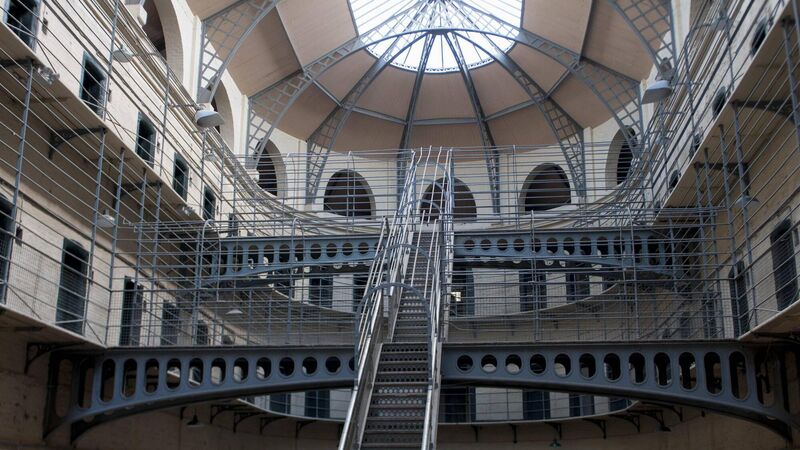Terry Prone: Kilmainham echoes with centuries of cruelty but remains relevant

Kilmainham Gaol is now a museum which records the lives and deaths of prisoners over the centuries, including those involved in the Easter Rising.
You might not think of visiting a prison as a cool trip for a bank holiday weekend, but it can be. Kilmainham Gaol alone attracts almost half a million visitors every year, even though much of the tour is remarkably grim, culminating in the yard where 1916 prisoners were executed. Coming up to this weekend, the place was crowded.
Some of the factors leading to incarceration are familiar, including violence driven by alcohol and although not in the 18th and 19th century, drugs. Vandalism. And homelessness, which led to savvy use of the Vagrancy Act, which was “designed for the Punishment of idle and Disorderly Persons, and Rogues and Vagabonds”.
Once the Famine struck, the numbers of “idle” and homeless people inevitably increased. They could go to the workhouse, from which they might never exit, and where conditions were horrific, or they could go to a prison like the one in Kilmainham, where the food was markedly better and the exit route was easier, because the sentences for vagrancy (as homelessness was called then), tended to be short. The food was a consequence of prison reformers believing you could not reform a person who was starving, and reformation was the name of the game, for the most part.
It was fascinating to hear from one of the tour guides that the practice of isolating and separating prisoners — which did them enormous damage — came about with the best of intentions. Separating prisoners obviated “moral contagion”, which may be assumed to include the kind of sexual exploitation associated with America’s prisons today, while also preventing or at least seeking to prevent prisons from becoming perverse training establishments, where old lags effectively apprenticed newcomers, training them in skills like pickpocketing and robbery.
To look through the peephole in the weathered door of a cell in the older wing of Kilmainham, even when the high window opposite the peephole is filled with spring sunlight, is to be chilled by the thought of what it must have been like to spend day after day, night after night there on one’s own
You imagine how important the noises of wardens arriving — the loud connection between boots and floors — although the guide then mentions an elaboration dreamed up by reformers who wanted isolation and separation to have maximum impact on each prisoner.
They ensured that the employees walking the stone corridors of the gaol wore felted overshoes, so they could creep along without making a sound, thus ensuring they could surprise prisoners who had the imagination to be doing something they shouldn’t be doing (i.e. anything) and remove them from the isolated the comfort of aural connection with the world directly outside their cell door. Nothing like the concentrated cruelty of the virtuous well-intentioned.
Mental health
Psychological studies in the 20th century hammered home that separation and isolation were grievously damaging to the mental health of prisoners. The breakdowns consequent on being kept away from others may have contributed to the perceived need in prisons like Kilmainham for a padded cell, where deranged prisoners were put — again on their own — and where they could do no damage to themselves, without the tools of self-harm, in a dark cell with the stone walls concealed behind strongly woven padded cotton. When a 21st century tourist pushes the partly open door of Kilmainham’s padded cell, where remnants of the cloth padding hang down, the guide gently suggests they’d be better off not actually going inside it. It’s not the cleanest.
The ultimate punishment for prisoners, of course, was execution. Oscar Wilde, in his Ballad of Reading Gaol, recorded the effect of the impending hanging of an imprisoned murderer on the others incarcerated with him but separated from him;
We sewed the sacks, we broke the stones,
We turned the dusty drill:
We banged the tins, and bawled the hymns,
And sweated on the mill:
But in the heart of every man
Terror was lying still.
The execution that so moved Wilde, driving him to produce his simplest and most moving work, seems to have been relatively private, whereas for centuries, prison hangings were public entertainment.
The word went out, in any big city, that a villain was to meet his comeuppance at a particular site on a stated morning, and the crowds would gather, tight-packed (all the better for the pickpockets), eating street food and ready to hear the condemned man or woman’s final words, often printed out in a pamphlet for purchase, the pamphlet designed to warn others off a life of crime as, indeed, was witnessing of the state-killing itself.
The great and the good, decade after decade, approved this widely witnessed destruction as a deterrent, with about as much evidence as the RSA currently has for its graphic TV/radio ads. Neither killing people in public nor simulating their death on TV has ever proven to improve the behaviour of the watchers. The watchers did, however, come up with terms to describe the agonised leg movements of those suffocating at the end of a noose. In Germany, someone dubbed it the Spandau Ballet, which became the name of a band.
Kilmainham Gaol is now a museum, recording the lives and deaths of prisoners over the centuries. I visited with clients planning their own specialist museum and was fearful — in a way those building museums in the past would not have been. Museums are unexpected foci of controversy, right now.
The British Museum, for example, last week appointed a new director, Dr Nicholas Cullinam, following the departure of former director Dr Hartwig Fischer, who, in the typical weasel-wording of such apologies, claimed the museum “did not respond as comprehensively as it should have” when a few artifacts went missing. To clarify: by “a few artifacts” we mean more than 1,500. Since one of the biggest attractions at the British Museum is the Elgin Marbles, stolen from Greece at the beginning of the 19th century, a slight feeling of sympathy for the artifact thief might be understandable.
In the past, museums were the essence of dull and proper, not least because, back then, it was considered OK that some of the stuff on display was nicked by colonialists. That even applied to the Benin bronzes in our own National Museum. Now, museums are hotbeds of controversy, as in Coniston, Cumbria, where the Ruskin Museum, a few weeks ago, put Donald Campbell’s Bluebird on display.
Campbell sought to break the world water speed record in the beautiful hydroplane in 1967, pushing it to 300 miles an hour before it flipped, killing him. Now, members of a team involved in the recovery and restoration of Bluebird are at loggerheads with the museum where it’s on display, a dispute, like so many others around museums and exhibitions, about ownership.
Past portrayal of individuals, groups and genders also generate criticism. The positive angle in all of this is that museums create a dialogue between past, present, and future and are made more relevant by that process.
CONNECT WITH US TODAY
Be the first to know the latest news and updates














